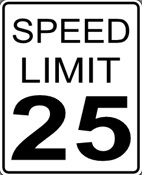Caution: Speed Zone Ahead
 |
About the presenter: Florence Myers, Ph.D., CCC/SLP is a Professor at Adelphi University, Garden City, New York. She has published widely in the areas of cluttering and stuttering. Her current interests include the nature of cluttering and how it relates to stuttering, as well as treatment approaches to cluttering. She was co-chair of the executive committee to organize the First International Conference on Cluttering held in Bulgaria, May 12-14, 2007. |
Caution: Speed Zone Ahead
by Florence Myers
from New York, USA
 As cluttering is often considered a rate-based disorder, clinicians may find it effective to use analogies and activities that focus on the effects of speaking faster than one can handle. One such activity incorporates the analogy of a car speedometer, and the issuing of speeding tickets when driving too fast. The clinician and client can take turns being the driver and highway officer issuing the tickets. Clients need first to develop
As cluttering is often considered a rate-based disorder, clinicians may find it effective to use analogies and activities that focus on the effects of speaking faster than one can handle. One such activity incorporates the analogy of a car speedometer, and the issuing of speeding tickets when driving too fast. The clinician and client can take turns being the driver and highway officer issuing the tickets. Clients need first to develop  skills in monitoring their speaking rate. This can be done by setting a standard, either internally or by listening to a taped sample of an appropriate target rate (analogous to the miles/kilometers per hour speed limits posted on road signs). The client is asked to gauge his rate according to the speed "posted" by the clinician. By purposefully varying the speaking rate (at 65 MPH, 55 MPH, 40 MPH and so forth), the client develops skills in monitoring and modulating his rate. The analogy of driving a car can also be extended by discussing consequences of driving too fast: getting speeding tickets and losing full control of the car. Discuss with the client what can happen when we speak too fast: sounds get jumbled up or get dropped (e.g., "telscope" for "telescope") , use of maze behaviors such as fillers and revisions that disrupt the efficient flow of the message, elements of a narrative that are not well organized thereby reducing the coherence or cohesiveness of the storyline. In other words, speaking faster than we can handle may make it difficult to manage all the "maneuvers" of the speech and language production system. The analogy can be extended by discussing the "road (i.e., speaking) conditions" that dictate how fast we can effectively talk. For example, we need to be especially vigilant of speaking conditions that incur speeding when we talk, such as when relating an exciting event that just happened. Used for behavioral feedback, "speeding tickets" can be in the form of citations about one's speech intelligibility, one's fluency, the appropriate use of rate, and clarity of one's overall communicative output. The roles of "driver" and "ticket issuer" can be reversed from time to time. Youngsters love to give speeding tickets to their speech teacher!
skills in monitoring their speaking rate. This can be done by setting a standard, either internally or by listening to a taped sample of an appropriate target rate (analogous to the miles/kilometers per hour speed limits posted on road signs). The client is asked to gauge his rate according to the speed "posted" by the clinician. By purposefully varying the speaking rate (at 65 MPH, 55 MPH, 40 MPH and so forth), the client develops skills in monitoring and modulating his rate. The analogy of driving a car can also be extended by discussing consequences of driving too fast: getting speeding tickets and losing full control of the car. Discuss with the client what can happen when we speak too fast: sounds get jumbled up or get dropped (e.g., "telscope" for "telescope") , use of maze behaviors such as fillers and revisions that disrupt the efficient flow of the message, elements of a narrative that are not well organized thereby reducing the coherence or cohesiveness of the storyline. In other words, speaking faster than we can handle may make it difficult to manage all the "maneuvers" of the speech and language production system. The analogy can be extended by discussing the "road (i.e., speaking) conditions" that dictate how fast we can effectively talk. For example, we need to be especially vigilant of speaking conditions that incur speeding when we talk, such as when relating an exciting event that just happened. Used for behavioral feedback, "speeding tickets" can be in the form of citations about one's speech intelligibility, one's fluency, the appropriate use of rate, and clarity of one's overall communicative output. The roles of "driver" and "ticket issuer" can be reversed from time to time. Youngsters love to give speeding tickets to their speech teacher!
DATE: March 6, 2010

